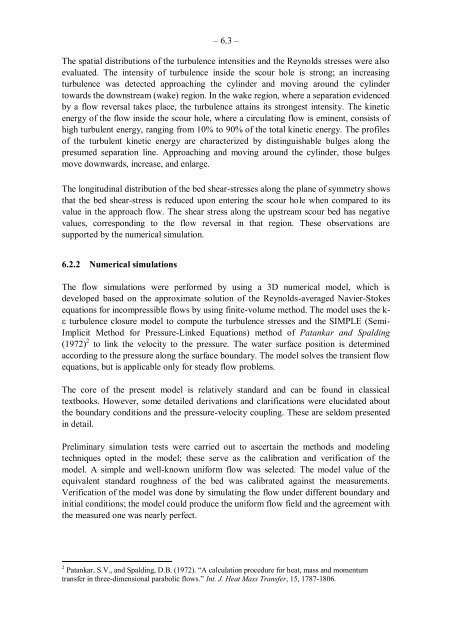Create successful ePaper yourself
Turn your PDF publications into a flip-book with our unique Google optimized e-Paper software.
– 6.3 –<br />
The spatial distributions of the turbulence intensities and the Reynolds stresses were also<br />
evaluated. The intensity of turbulence inside the scour hole is strong; an increasing<br />
turbulence was detected approaching the cylinder and moving around the cylinder<br />
towards the downstream (wake) region. In the wake region, where a separation evidenced<br />
by a flow reversal takes place, the turbulence attains its strongest intensity. The kinetic<br />
energy of the flow inside the scour hole, where a circulating flow is eminent, consists of<br />
high turbulent energy, ranging from 10% to 90% of the total kinetic energy. The profiles<br />
of the turbulent kinetic energy are characterized by distinguishable bulges along the<br />
presumed separation line. Approaching and moving around the cylinder, those bulges<br />
move downwards, increase, and enlarge.<br />
The longitudinal distribution of the bed shear-stresses along the plane of symmetry shows<br />
that the bed shear-stress is reduced upon entering the scour hole when compared to its<br />
value in the approach flow. The shear stress along the upstream scour bed has negative<br />
values, corresponding to the flow reversal in that region. These observations are<br />
supported by the numerical simulation.<br />
6.2.2 Numerical simulations<br />
The flow simulations were performed by using a 3D numerical model, which is<br />
developed based on the approximate solution of the Reynolds-averaged Navier-Stokes<br />
equations for incompressible flows by using finite-volume method. The model uses the k-<br />
� turbulence closure model to compute the turbulence stresses and the SIMPLE (Semi-<br />
Implicit Method for Pressure-Linked Equations) method of Patankar and Spalding<br />
(1972) 2 to link the velocity to the pressure. The water surface position is determined<br />
according to the pressure along the surface boundary. The model solves the transient flow<br />
equations, but is applicable only for steady flow problems.<br />
The core of the present model is relatively standard and can be found in classical<br />
textbooks. However, some detailed derivations and clarifications were elucidated about<br />
the boundary conditions and the pressure-velocity coupling. These are seldom presented<br />
in detail.<br />
Preliminary simulation tests were carried out to ascertain the methods and modeling<br />
techniques opted in the model; these serve as the calibration and verification of the<br />
model. A simple and well-known uniform flow was selected. The model value of the<br />
equivalent standard roughness of the bed was calibrated against the measurements.<br />
Verification of the model was done by simulating the flow under different boundary and<br />
initial conditions; the model could produce the uniform flow field and the agreement with<br />
the measured one was nearly perfect.<br />
2 Patankar, S.V., and Spalding, D.B. (1972). ―A calculation procedure for heat, mass and momentum<br />
transfer in three-dimensional parabolic flows.‖ Int. J. Heat Mass Transfer, 15, 1787-1806.

















